You’ve likely encountered the term “social proof” and observed how savvy ecommerce businesses use it to their advantage.
But what exactly is social proof? Why is it essential to integrate it into your website?
And most importantly, how can you effectively use it in your marketing strategy?
Social proof isn’t just a buzzword; it’s a powerful marketing tool with the potential to boost profits significantly.
Surprisingly, many online merchants either underutilize it or overlook it entirely.
My mission? It is to teach you all about social proof and social proof marketing.
Let’s get started!
- What Is Social Proof
- Why Is Social Proof Important
- Examples of Social Proof
- How to Build Social Proof
What Is Social Proof
Social proof is a psychological and social phenomenon wherein individuals look to the actions, behaviors, and decisions of others to determine what is correct or acceptable behavior in a given situation.
Essentially, it’s the idea that people will conform to the actions of others under the assumption that those actions reflect the correct behavior.
The concept of social proof is rooted in the principle that when individuals are uncertain about a decision, they will often look to others, especially large groups or trusted figures, as a guide for their own actions.
Robert Cialdini popularized the concept of social proof in his seminal book, “Influence: The Psychology of Persuasion.” Cialdini identified social proof as one of the six key principles of persuasion, emphasizing its power in shaping human behavior.
Understanding and leveraging social proof has become essential for businesses and marketers in a world dominated by digital interactions.
Why Is Social Proof Important
Social proof is important because of the following key factors:
- Trust and Credibility: When potential customers see others vouching for a product or service, it builds trust. Positive testimonials, online reviews, and endorsements act as stamps of approval, signaling that a product or service is reliable and high-quality.
- Reduces Uncertainty: Social proof provides reassurance for a first-time buyer or someone unfamiliar with a brand. Seeing others make similar choices minimizes the fear of making a wrong decision.
- Human Nature: By nature, humans are social beings. We often look to our peers for cues on how to behave, especially in unfamiliar situations. Social proof taps into this innate tendency, guiding behaviors and choices.
- Boosts Conversions: From a business perspective, social proof can significantly enhance conversion rates. When potential customers see real-life proof of a product’s benefits, they’re more likely to make a purchase.
- Builds Brand Loyalty: Customers who see consistent positive feedback and community engagement around a brand foster a sense of belonging and loyalty.
In essence, social proof is not just a marketing tool; it’s a reflection of societal behaviors and preferences. Leveraging it effectively can be the difference between a thriving business and one that’s struggling to gain traction.
Bonus content: Social Proof Statistics: 42 Reasons Your Business Needs Social Proof
9 Examples of Social Proof
Social proof can be a powerful tool in marketing and business to influence consumers’ decisions. Examples of social proof in this realm include:
- Testimonials (Industry Expert Social Proof”)
- Ratings and reviews
- Social media signals
- Displays of current customers
- Active-participant counters
- Case studies
- Word-of-mouth
- Positive action notifications
- User-Generated Content
1. Testimonials (Industry Expert Social Proof)
Testimonials top our list for social proof marketing. A testimonial is a quote from past or current customers that put your brand in a positive light. In other words, this is a stamp of approval.
Even though most of your site’s visitors won’t know the person giving the testimonial, it doesn’t matter. 91% of millennials trust reviews as much as
referral from their friends and family.
However, to boost conversions, you should add a small photo of the person giving the testimonial. This makes their recommendation feel more personal and lends it more credibility.
Here is an excellent example of social proof, a perfectly crafted testimonial for SEMrush:
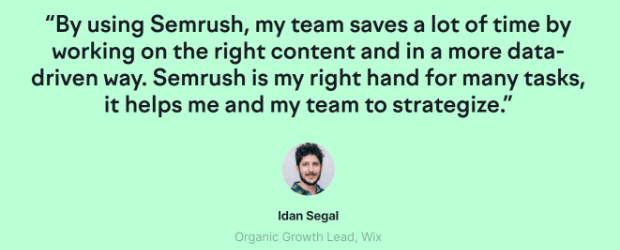
There is a photo of the speaker, a glowing testimonial, and the added benefit of a company name that many of SEMrush’s target audience would recognize.
Want to add some testimonials to your site? Check out this resource on ten customer testimonial examples you can use.
2. Ratings and Reviews
Reviews are important for all businesses, but particularly for restaurants, brick-and-mortar shops, businesses selling through 3rd party sites like Amazon, and eCommerce sites. Regarding online reviews, two types can work in your favor: influencer reviews and customer reviews.
Celebrity social proof and influencer marketing reviews are incredibly powerful. If you get a celebrity endorsement, you likely want to turn that into a testimonial or perhaps even a case study (which we’ll discuss later).
Customer reviews can be just as powerful, but you need more to be effective. The average consumer reads up to ten reviews before purchasing a product.
Reviews typically have two parts: a 5-star rating system followed by some text describing the product or service. Here’s an example of a review from OptinMonster’s homepage:
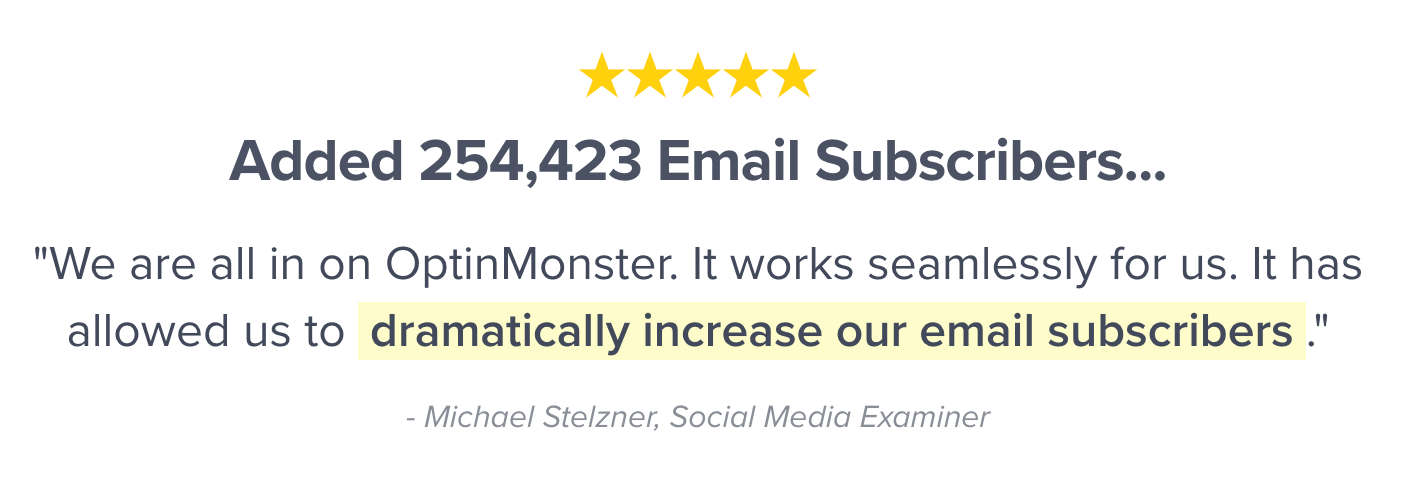
5-star ratings give readers a glance at the overall review, but written content provides more detail about what made the product or service good or bad. When you have both the quick-glance rating and detailed information, you have a killer review on your hands.
And chances are, people will read it.
Research shows 83% of people prefer reviews over advertising, which makes sense. You can speak highly about your product until you’re blue in the face, but people take your words with a grain of salt, considering your connection to the business.
Seeing a client take the time to write either a positive review or a negative review about your company inspires other consumers to take either a positive or negative action. Again, social proof is still powerful, even if the reviews are from total strangers.
3. Social Media Signals
When it comes to using social media to boost your social proof, there are three factors to take into consideration:
1) The number of followers: The more followers you have, the more likely you are to gain more:
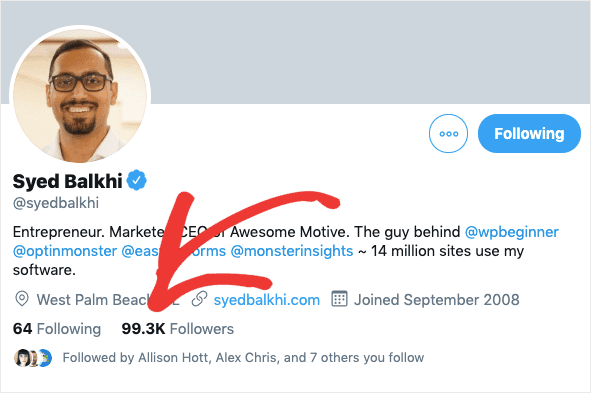
2) The number of likes: Social media posts with more likes are typically shared more and help to boost engagement further:

3) Overall interaction: If you’ve strueck up a conversation or post online and many people are taking the time to reply, that can encourage more people to throw in their 2 cents on the subject:

Out of those three, which one is the most important?
None, because they should all work together.
Marketers are increasingly realizing that the number of followers isn’t more powerful than the overall interaction taking place. An Instagram influencer, for example, may have four million followers, but if none are engaged with the brand or replying to comments, the brand’s social proof is still pretty weak.
If you want to use social media, you should increase followers, likes, and interactions instead of focusing on only one metric. For example, trending on Twitter helps a great deal, but that is only temporary.
All of these social media metrics are a great demonstration of social proof.
It’s one of the main reasons why you might also want to consider adding social media share buttons across your site. This will help your site’s traffic share your social media posts which will build even more social proof on that platform.
4. Displays of Current Customers
Our next social proof marketing example is to list any high-profile clients you’re currently working with (or have worked with in the past).
Showing that well-known brands or influential people have worked with you in the past isn’t bragging. It’s simply leveraging the power of social proof in your favor. By displaying established and trusted brands that have worked with you, your brand can borrow some of their credibility.
Here’s an example from AHREFS’ homepage showing the companies that use their software:

If you’ve ever worked with recognizable companies, don’t be shy! Display them proudly on your website.
5. Active-Participant Counters
A common eCommerce marketing strategy for building urgency is a countdown timer letting customers know when a promotion will finish. But if you want to use social proof, you need the exact opposite: a counter that goes up rather than down.
You need an active participant counter to show how many people have used or are using your site.
Kickstarter is an excellent example of a company that relies on this form of social proof to encourage donations:

The higher that counter becomes, the more effective it is. People who see that others have donated to a project are much more likely to contribute.
Here’s another excellent example from Awesome Motive:
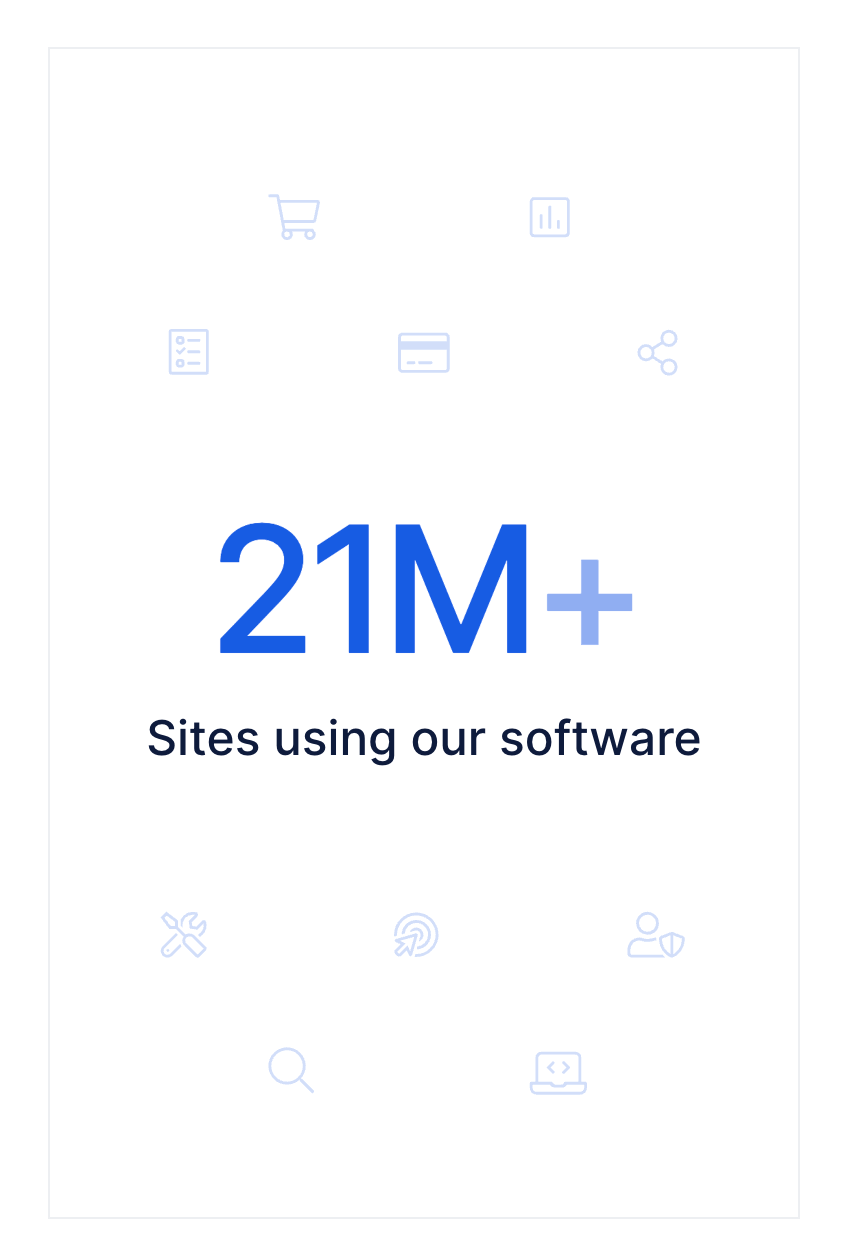
Showing people in real-time how many customers are using your brand is a very powerful social proof strategy. It’s a perfect use of the FOMO (fear of missing out) tactic we talked about earlier. If people see so many others are using your products or services, they won’t want to miss out on the action. This will inspire them to buy from you.
6. Case Studies
We have already looked at how reviews and testimonials can help boost conversions, but case studies are another great social proof tool. They’re like a long-form testimonial that details someone’s success with your product.
Case studies usually take the form of a blog post, newsletter, or video, but you can make and distribute them however you see fit. The point is to dive deeply into a customer’s experience with your product and allow them to share it with others through storytelling.
When creating a case study, the key is to be as thorough and detailed as possible.
A few questions your case study should answer are:
- What limitations did your client face?
- How did they overcome it?
- Why did they choose you over the competition?
- How much success did they have?
- Can they show concrete data to support it?
By answering questions like these, you’ll build a case study that other consumers can read to sway them into purchasing with your brand.
7. Word-of-Mouth
They say that your best marketers are your happy customers.
And they’re right.
The power of word-of-mouth shouldn’t be underestimated. Plenty of companies have used word-of-mouth marketing to build their clientele. Companies like Uber, Airbnb, Transferwise, and many more offer incentives for signing up new customers:
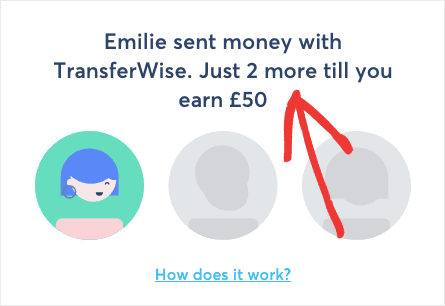
When you share a company with a friend to get the reward, you’re also vouching for the company with your reputation, and that’s social proof marketing in action.
Since you’re likely only reaching out to friends and family with those deals, you’re acting as social proof on behalf of the company you’re suggesting.
You can do the same thing with your brand. Offer your potential customers an incentive to refer people in their social network, and you’ll build your brand’s social proof in no time!
Word-of-mouth is an excellent form of marketing, but when it comes to eCommerce social proof, it’s something you’ll need to focus on.
8. Positive Action Notifications
One of the best ways to provide your visitors with social proof is by displaying real-time action notifications as a popup. You’ve likely seen these before:

While your visitors are checking out your site, they’ll be notified whenever someone makes a positive action, like making a purchase, viewing a product page, or signing up for your newsletter, to name a few.
This little dose of social proof affects purchase rates in a big way. It can boost conversions by up to 15% and is becoming a more popular social proof marketing strategy every day.
But what if you’re new to the world of eCommerce, and you still need to get social proof? Don’t worry. There’s a lot you can do to quickly gather reviews, testimonials, and social media followers in no time.
9) User-Generated Content
User-generated content (UGC) is a form of social proof that refers to using content created by actual users or customers to establish credibility, build trust, and influence among potential customers or clients.
UGC can take various forms, including customer reviews, testimonials, photos, videos, social media posts, and blog comments. It offers an authentic and unbiased perspective on a product or service, as it is generated by individuals who have direct experience with the brand.
How to Build Social Proof
If you’re starting out, here are five ways you can quickly build social proof:
- Host an online contest that gives a prize to the most creative product review (we highly recommend using an online giveaway tool like RafflePress for this)
- Put a customer review or testimonial form on your website and link it to your email campaigns.
- Reach out to your favorite or most loyal clients for a testimonial
- Ask your social media followers what they love about your product and get them interacting with your brand online.
- Use honest and genuine software specializing in positive action notification popups to display when you get new subscribers, or your visitors make a purchase.
You’ll notice a common theme among these strategies: engaging with your audience.
That’s why it’s so important to avoid fake social proof. You may purchase a large following, but it’s easy for your real audience to notice that no one is interacting with your brand.
A smaller, highly engaged audience is far better than a large, silent audience.
Pro tip: The most important tip isn’t something you should do. Instead, it’s something you should never do: rely on fake social proof.
Some companies try to kickstart their credibility by creating or buying fake testimonials or reviews. Or they buy followers to boost their metrics on social media.
Other businesses even rely on social proof plugins that allow you to display positive action notification popups that aren’t real. They would show that a person “bought” their product even if the purchase never happened.
There are so many reasons to avoid using fake social proof, but here’s the main one:
It’s easy to build social proof authentically; there’s no excuse not to.
Besides, adding fake social proof will only damage your business’s authenticity and credibility.
Start Social Proofing Your Website
Social proof should now be an important part of your digital marketing strategy. The best way to showcase eCommerce social proof (or social proof for any site) is by using TrustPulse.
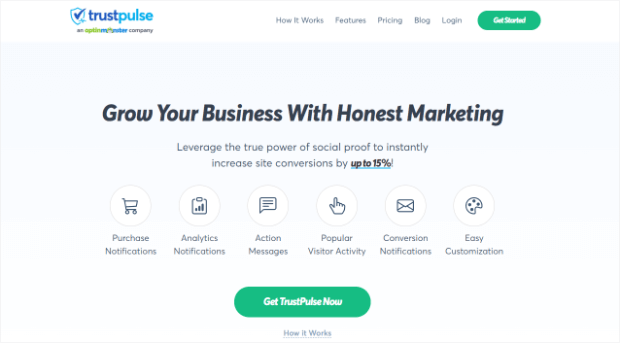
TrustPulse is the best social proof software on the market. With TrustPulse, you can quickly and easily display social proof notifications across your site. That includes notifications like when visitors:
- Sign up for your newsletters
- Register for a webinar
- Leave your company a review on 3rd-party sites like Google My Business or Yelp
- Purchase a product from your online store
- Click through to landing pages or product pages
And more
In other words, you’ll be showing the positive actions of others to motivate your site’s traffic into action. Plus, it doesn’t require any coding skills to get started.
You can also add a link to the notifications so that each message acts as a call to action (CTA) button.
Plus, you can use the Zapier integration to create notifications for 3rd-party review sites. This will show whenever someone leaves you a 5-star review on sites like Yelp, G2, Capterra, and more.
As a result, you can expect to build more trust with your site’s visitors and, ultimately, make more sales.
And the best part is that you can use TrustPulse for a fraction of the cost compared to the closest competitors. Whereas other social proof software can cost up to $20-$30/month, TrustPulse’s paid plans begin at $5/month.
This makes it the perfect tool for businesses of all sizes: from 8-figure companies to solo bloggers looking for more readers.
For more information on how TrustPulse stacks up to the competition regarding pricing and features, check out this helpful post: FOMO vs. UseProof vs. TrustPulse: Which Is Best for Social Proof?
Ready to get started building credibility with your audience and instantly boosting sales?
